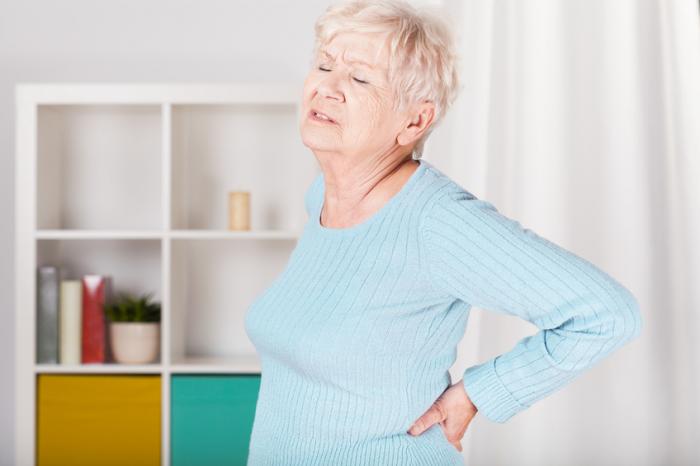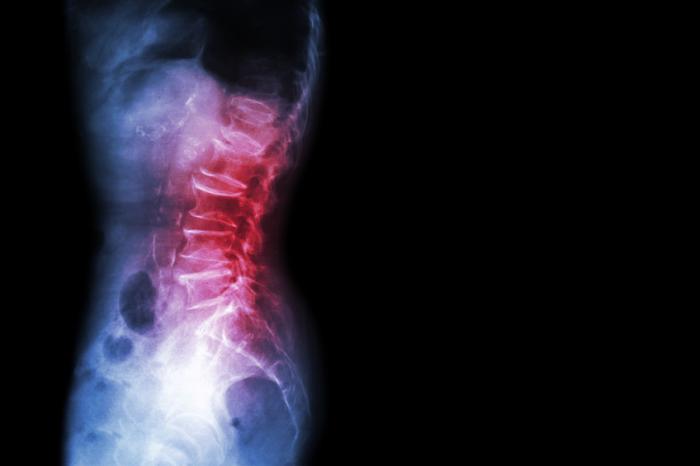Spondylosis is wear-and-tear changes to the spine. Most people show spondylosis in their spine as they get older. These age-related differences in the spine vary from one person to the next and do not usually cause problems.
When spondylosis does cause symptoms, they are usually occasional pain and stiffness.
Spondylosis in the neck is called cervical spondylosis. Spondylosis changes can also be seen in other segments of the spine, including the lumbar region, or lower back.
People are more likely to get spondylosis as they age. One article that reviewed the evidence appeared in the journal Neurosurgery. It suggested that spondylosis may be seen in 10 percent of people by the age of 25 years – but in 95 percent by the age of 65. Only some people have problems as a result.
Just about everyone over 70 years of age is likely to show some spondylosis on spine X-rays. Researchers have confirmed that the wear and tear affects almost everyone.
Spinal osteoarthritis is another term used for spondylosis. Osteoarthritis is the type of arthritis caused by wear and tear, and can affect any joint in the body.
Contents of this article:
- Causes of spondylosis
- Symptoms of spondylosis
- Treatment of spondylosis
Causes of spondylosis
The spine is the backbone, running from the base of the head to the tailbone. This part of the skeleton gives the body structure and supports most of its weight. It also carries and protects almost all of the main nerve branches that run from the brain.
The spine has an elegantly curved shape. It is a column made up of bones known as vertebrae. These vertebrae have joints between them to allow the spine to move flexibly.
The bones of vertebrae are separated by softer, rubbery tissues. These cartilage surfaces and discs between the vertebrae give smooth movement and cushion against any impact on the bones.

Both facet joints and cartilage between the vertebrae break down over time due to wear and tear.
As bodies get older, the discs gradually age. They lose some of their cushioning ability because they become drier. This makes the discs thinner and harder.
The other main contact between one vertebra and the next is formed by the facet joints. These joints also break down with age because of wear and tear on their cartilage surfaces.
The body can respond to the spondylosis. More growth of bone can happen, triggered by the direct contact of bones rubbing against each other. Spondylosis can then result in bony growths known as spurs or projections.
The loss of rubbery tissues and the formation of spurs make the spine stiffer. Back movement also becomes less smooth. There is more friction between the bones of the spine.
For some people, symptoms worse than general stiffness can also arise from these changes in the spine.
Spondylosis can result in a narrowing of the canal that carries the spinal cord nerves. Doctors call this spinal stenosis. Changes to the spinal bones can also rub against spinal nerves, causing problems.
Spondylosis risk factors
Daily wear and tear on the muscles and bones over time is the overall cause of spondylosis.
These changes affect different people to varying extents, and genetics have a great influence. Some people, for example, are born with narrower spinal canals, which are more prone to problems when they narrow down.
Risk factors for spondylosis include:
- Overweight and obesity
- Not doing exercise or leading a sedentary life
- Previous injury or surgery to the spine
Other factors that are linked to worse problems with spondylosis include:
- Smoking
- Jobs involving repetitive or weight-bearing actions on the spine
- Psychological ill health such as anxiety and depression
Symptoms of spondylosis
Most people who have spondylosis in their spine as they get older do not experience any symptoms.

Symptoms of spondylosis are not usually troublesome. However, there are instances when changes to the spine can affect the nerves.
For people who do get symptoms, they are usually not too troublesome. Spondylosis can cause some stiffness and mild pain. This can occasionally get worse with certain movements or prolonged periods without movement
Only some people with spondylosis experience bad pain. In some cases, the changes to the spine can affect the nerves. If the bone narrows up the space for the spinal cord, it can put pressure on it, irritating it or damaging it.
Disease of the spinal nerves can then result in symptoms such as numbness, tingling sensations, and weakness. In neck spondylosis, this can affect the arms, hands, or fingers. In lumbar spondylosis, the legs may be affected.
Cervical spondylosis can pinch on a nerve for the neck so that it causes a strange sensation. This type of neck problem is called radiculopathy. Here, the neck muscle can feel numb or weak.
Other symptoms can include:
- Muscle spasm and pain
- Loss of balance and trouble walking
- A sensation of grinding or popping that can happen during movement of the spine
- Headaches
Symptoms will differ according to the part of the spine affected. Spondylosis in the lower back may produce symptoms that affect sitting. With a problem in the lower spine, muscle weakness or other nerve-related problems will affect the legs rather than the neck or arms. The neck and arms are affected by the more common case of spondylosis in the neck.
Treatment of spondylosis
Most cases of spondylosis do not need treatment as they produce only mild, occasional problems of stiffness and pain.
General advice for a non-troubling case of pain due to spinal aging is to:
- Using over-the-counter painkillers
- If the label allows and there have been no problems with using NSAIDs, these are the recommended drugs – ibuprofen is one example of an NSAID
- Keeping physically active
Exercise can loosen stiff joints and strengthen other muscles that will support the aging spine. Rest is needed when pain is bad, though.
Physical therapists are among the healthcare providers who can help with exercise advice. They can also do physical manipulation with therapies such as massage.
![[Back Pain]](http://www.medicinetechnews.com/images/201608/bac-pain.jpg)
Surgery is rarely required and a last option in cases where other spondylitis treatments have failed.
If pain is persistent or particularly bad, doctors can help by offering drug treatments that are available only on prescription. These include:
- Higher doses of painkillers, or more powerful ones such as codeine
- Steroids by tablet, or injections for severe pain
The steroid injection is aimed at relieving pain for a while by reducing inflammation. In the case of neck spondylitis, it is given to reach the nerve roots that come out of the part of the spine affected.
Other drugs that are sometimes used include:
- Muscle relaxants if there is a problem with muscle spasm
- Nerve pain drugs
- Topical creams
Patients should always follow the advice of doctors and pharmacists about the effects of drugs and how medications should be used.
Surgical treatment
Surgery is always the last option after other spondylosis treatments have failed. An operation is only an option in a limited number of cases where the problem is severe, including because of lasting bad pain.
Severe problems where spondylosis could require surgery include when:
- Nerves serving the body are being pinched and causing serious numbness or weakness
- The spinal cord itself is being diseased by the spine changes and nervous system damage is likely to get worse without surgery
The surgeons will do whatever operation matches the exact problem with the spine. This will be planned against the overall clinical signs and the findings of scans such as X-rays.
Examples of surgical procedures to treat complications of spondylosis include:
- Removal of the disc or piece of bone that is causing the problem against the nerves – nearby vertebrae become fused after the operation
- Replacement of a disc – an artificial disc replaces a worn-out one
Most people with spondylosis do not need an operation. Any surgery carries risks, but the chances of these should be outweighed by the potential improvements.
Operations need a recovery period, followed by weeks and months before the patient is completely fit again.